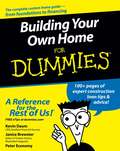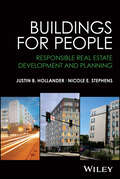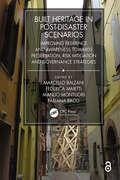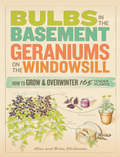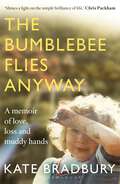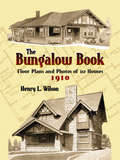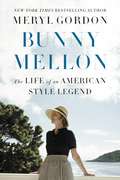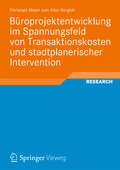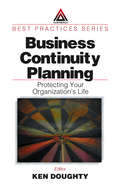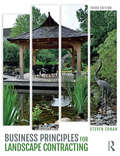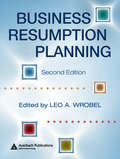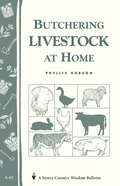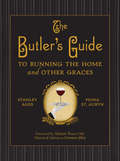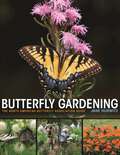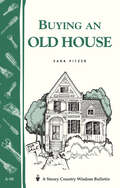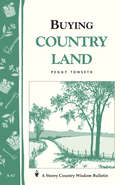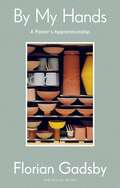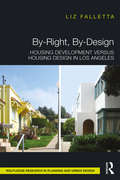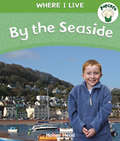- Table View
- List View
Building Your Own Home For Dummies
by Kevin Daum Janice Brewster Peter EconomyKeep construction on track with helpful checklists Turn your dream of a custom home into reality! Thinking about building your own home? This easy-to-follow guide shows you how to plan and build a beautiful home on any budget. From acquiring land to finding the best architect to overseeing the construction, you get lots of savvy tips on managing your new investment wisely -- and staying sane during the process! Discover how to: * Find the best homesite * Navigate the plan approval process * Obtain financing * Hire the right contractor * Cut design and construction costs * Avoid common mistakes
Building Your Own Home For Dummies
by Kevin Daum Janice Brewster Peter EconomyKeep construction on track with helpful checklists Turn your dream of a custom home into reality! Thinking about building your own home? This easy-to-follow guide shows you how to plan and build a beautiful home on any budget. From acquiring land to finding the best architect to overseeing the construction, you get lots of savvy tips on managing your new investment wisely -- and staying sane during the process! Discover how to: * Find the best homesite * Navigate the plan approval process * Obtain financing * Hire the right contractor * Cut design and construction costs * Avoid common mistakes
Buildings for People: Responsible Real Estate Development and Planning
by Justin B. Hollander Nicole E. StephensBUILDINGS FOR PEOPLE Buildings for People: Responsible Real Estate Development and Planning explores how to balance social concerns with financial and investment considerations without sacrificing profit. This timely volume provides key technical and practical knowledge while exploring real estate development and planning through a multi-level lens—revealing the systemic factors that both govern and are governed by the real estate process. Beginning with site selection, the authors discuss financing, site improvement, architecture, landscape architecture, site planning, construction, and evaluation within a broader political, economic, and social context. Throughout the text, the authors explain key theories and methods of professional practice, and highlight how important social issues are interconnected to the business of real estate development and planning. Demonstrating how the desire for profit can be balanced with the needs of society Buildings for People: Responsible Real Estate Development and Planning is an excellent textbook for advanced undergraduate and graduate students in real estate, urban planning, urban design, and urban studies courses, as well as a valuable resource for researchers and professionals who want a multidisciplinary understanding of the built environment.
Buildings for People: Responsible Real Estate Development and Planning
by Justin B. Hollander Nicole E. StephensBUILDINGS FOR PEOPLE Buildings for People: Responsible Real Estate Development and Planning explores how to balance social concerns with financial and investment considerations without sacrificing profit. This timely volume provides key technical and practical knowledge while exploring real estate development and planning through a multi-level lens—revealing the systemic factors that both govern and are governed by the real estate process. Beginning with site selection, the authors discuss financing, site improvement, architecture, landscape architecture, site planning, construction, and evaluation within a broader political, economic, and social context. Throughout the text, the authors explain key theories and methods of professional practice, and highlight how important social issues are interconnected to the business of real estate development and planning. Demonstrating how the desire for profit can be balanced with the needs of society Buildings for People: Responsible Real Estate Development and Planning is an excellent textbook for advanced undergraduate and graduate students in real estate, urban planning, urban design, and urban studies courses, as well as a valuable resource for researchers and professionals who want a multidisciplinary understanding of the built environment.
Built Heritage in post-Disaster Scenarios: Improving Resilience and Awareness Towards Preservation, Risk Mitigation and Governance Strategies
by Marcello BalzaniIt is assumed that the impact of natural and man-made hazards on society in terms of damage cannot be avoided. To reduce potential disaster levels and to assess which policies have had a positive outcome, a careful comparison should take place on the procedures implemented in the management of crises.The experiences with the earthquakes in the Pianura Padana area and central regions of Italy in the last ten years have been incorporated in the 'After the Damages' advanced training project. This project aims to showcase recent innovations and advancements in post-disaster management, so as to take a more proactive role in post-disaster management, and to respond more effectively when disasters occur.This volume provides insights into the dynamics and negative effects of natural and man-made hazards (i.e., earthquakes, fires, floods, droughts, volcanic eruptions, etc.), including more updated approaches to deal with post-disaster phases. The book also offers tools to deal with possible international crisis scenarios and mitigate the social impact of vulnerabilities through risk reduction.Built Heritage in post-Disaster Scenarios aims at public administration managers, government agency representatives, international organizations, researchers, and professionals in architecture, engineering, and earth science.Marcello Balzani, Architect, PhD in "Representation and Survey", Full Professor of Representation at the Department of Architecture, University of Ferrara. President of Clust-ER Building and Construction. He is author of more than 200 publications on the themes of Drawing and Architectural and Urban Surveying, Project Representation, Management and Visualisation.Federica Maietti, Architect, PhD, Associate Professor in the Scientific Sector ICAR/17 at the Department of Architecture, University of Ferrara. Member of the DIAPReM Centre, since 2005 she carries out research activities in the fields of heritage documentation, survey and diagnostic investigations, in different national and international contexts, including Pompeii, Malta, Brazil, India, and Mexico. Scientific Manager of the International Academy "After the Damages", she is involved in several research activities and she is the author of more than two hundred publications in the field of Heritage Documentation, Survey and Representation.Manlio Montuori, Architect, PhD, former assistant professor non-tenured at the University of Ferrara, Department of Architecture, where he is a member of the Labo.R.A. The main field of his research is the conservation of architectural heritage and landscape, with special emphasis on preservation procedures for traditional and industrial built heritage. His research interests also address assessment and management in the context of damage and disaster risk reduction. Scientific Manager of the International Academy "After the Damages", he is involved in several research projects implementing ICT technologies in the conservation and structural health assessment of built and cultural heritage.Fabiana Raco, Architect, PhD RTDa Researcher of Drawing at the Department of Architecture, University of Ferrara. Technical coordinator of TekneHub Laboratory. Author of more than 50 publications on the topics of Drawing, Architectural and Urban Surveying, Representation, Diagnostics, Visualization and Project Management of interventions on built heritage.
Built Heritage in post-Disaster Scenarios: Improving Resilience and Awareness Towards Preservation, Risk Mitigation and Governance Strategies
It is assumed that the impact of natural and man-made hazards on society in terms of damage cannot be avoided. To reduce potential disaster levels and to assess which policies have had a positive outcome, a careful comparison should take place on the procedures implemented in the management of crises.The experiences with the earthquakes in the Pianura Padana area and central regions of Italy in the last ten years have been incorporated in the 'After the Damages' advanced training project. This project aims to showcase recent innovations and advancements in post-disaster management, so as to take a more proactive role in post-disaster management, and to respond more effectively when disasters occur.This volume provides insights into the dynamics and negative effects of natural and man-made hazards (i.e., earthquakes, fires, floods, droughts, volcanic eruptions, etc.), including more updated approaches to deal with post-disaster phases. The book also offers tools to deal with possible international crisis scenarios and mitigate the social impact of vulnerabilities through risk reduction.Built Heritage in post-Disaster Scenarios aims at public administration managers, government agency representatives, international organizations, researchers, and professionals in architecture, engineering, and earth science.Marcello Balzani, Architect, PhD in "Representation and Survey", Full Professor of Representation at the Department of Architecture, University of Ferrara. President of Clust-ER Building and Construction. He is author of more than 200 publications on the themes of Drawing and Architectural and Urban Surveying, Project Representation, Management and Visualisation.Federica Maietti, Architect, PhD, Associate Professor in the Scientific Sector ICAR/17 at the Department of Architecture, University of Ferrara. Member of the DIAPReM Centre, since 2005 she carries out research activities in the fields of heritage documentation, survey and diagnostic investigations, in different national and international contexts, including Pompeii, Malta, Brazil, India, and Mexico. Scientific Manager of the International Academy "After the Damages", she is involved in several research activities and she is the author of more than two hundred publications in the field of Heritage Documentation, Survey and Representation.Manlio Montuori, Architect, PhD, former assistant professor non-tenured at the University of Ferrara, Department of Architecture, where he is a member of the Labo.R.A. The main field of his research is the conservation of architectural heritage and landscape, with special emphasis on preservation procedures for traditional and industrial built heritage. His research interests also address assessment and management in the context of damage and disaster risk reduction. Scientific Manager of the International Academy "After the Damages", he is involved in several research projects implementing ICT technologies in the conservation and structural health assessment of built and cultural heritage.Fabiana Raco, Architect, PhD RTDa Researcher of Drawing at the Department of Architecture, University of Ferrara. Technical coordinator of TekneHub Laboratory. Author of more than 50 publications on the topics of Drawing, Architectural and Urban Surveying, Representation, Diagnostics, Visualization and Project Management of interventions on built heritage.
Bulbs in the Basement, Geraniums on the Windowsill: How to Grow & Overwinter 165 Tender Plants
by Alice McGowan Brian McGowanCooler-zone gardeners are discovering that with a little wintertime care, plants that have long been considered "annuals" can thrive for years. These plants — including geraniums, gladioli, dahlias, begonias, rosemary, lavender, snapdragons, and even impatiens — aren't annuals at all. Rather, they are tender perennials. They aren't hardy enough to survive winter on their own, but they can be moved indoors during the cold months and then returned to the garden in spring. Many are even more beautiful in their second and third years! Bulbs in the Basement, Geraniums on the Windowsill is the first comprehensive resource on the care and maintenance of tender plants. In this zone-defying guide, you'll find simple techniques for overwintering, along with 160 detailed plant profiles that include individualized advice for overwintering and indoor care. With this practical guide, you can enjoy your favorite plants year after year, no matter where you live!
The Bumblebee Flies Anyway: A year of gardening and (wild)life
by Kate Bradbury'Wonderfully intense and honest - a poignant manual of how to grow hope against the odds.' Chris Packham, TV presenter and author of Fingers in the Sparkle JarFinding herself in a new home in Brighton, Kate Bradbury sets about transforming her decked, barren backyard into a beautiful wildlife garden. She documents the unbuttoning of the earth and the rebirth of the garden, the rewilding of a tiny urban space. On her own she unscrews, saws and hammers the decking away, she clears the builders' rubble and rubbish beneath it, and she digs and enriches the soil, gradually planting it up with plants she knows will attract wildlife. She erects bird boxes and bee hotels, hangs feeders and grows nectar- and pollen-rich plants, and slowly brings life back to the garden.But while she's doing this Kate's neighbours continue to pave and deck their gardens locking them away, the wildlife she tries to save is further threatened, and she feels she's fighting an uphill battle. Is there any point in gardening for wildlife when everyone else is drowning the land in poison and cement? Sadly, events take Kate away from her garden, and she finds herself back home in Birmingham where she grew up, travelling the roads she used to race down on her bike in the eighties, thinking of the gardens and wildlife she loved, witnessing more land lost beneath paving stones. If the dead could return, what would they say about the land we have taken, the ancient routes we have carved up, the wildlife we have lost?
The Bumblebee Flies Anyway: A year of gardening and (wild)life
by Kate Bradbury'Wonderfully intense and honest - a poignant manual of how to grow hope against the odds.' Chris Packham, TV presenter and author of Fingers in the Sparkle JarFinding herself in a new home in Brighton, Kate Bradbury sets about transforming her decked, barren backyard into a beautiful wildlife garden. She documents the unbuttoning of the earth and the rebirth of the garden, the rewilding of a tiny urban space. On her own she unscrews, saws and hammers the decking away, she clears the builders' rubble and rubbish beneath it, and she digs and enriches the soil, gradually planting it up with plants she knows will attract wildlife. She erects bird boxes and bee hotels, hangs feeders and grows nectar- and pollen-rich plants, and slowly brings life back to the garden.But while she's doing this Kate's neighbours continue to pave and deck their gardens locking them away, the wildlife she tries to save is further threatened, and she feels she's fighting an uphill battle. Is there any point in gardening for wildlife when everyone else is drowning the land in poison and cement? Sadly, events take Kate away from her garden, and she finds herself back home in Birmingham where she grew up, travelling the roads she used to race down on her bike in the eighties, thinking of the gardens and wildlife she loved, witnessing more land lost beneath paving stones. If the dead could return, what would they say about the land we have taken, the ancient routes we have carved up, the wildlife we have lost?
The Bungalow Book: Floor Plans and Photos of 112 Houses, 1910
by Henry L. WilsonCozy, charming, and distinctly Californian, the bungalow is an enduring architectural icon. Originally designed to survive earthquakes, the low, rambling structures combined grace, beauty, and comfort at minimum cost.Early in the twentieth century, Los Angeles architect Henry Wilson, who called himself "The Bungalow Man," compiled 112 of the most popular and economic bungalow blueprints of his time in a catalog for would-be homeowners. Complementing each set of prints was an illustration or photograph of the completed house, which most frequently contained two or three bedrooms with closet space, living and dining rooms, a kitchen with pantry, and a bath.An ideal reference for preservationists and restorers, this reprint of Wilson's rare catalog represents a wonderful time capsule and invaluable guide to a popular style of American domestic architecture.
Büroprojektentwicklung im Spannungsfeld von Transaktionskosten und stadtplanerischer Intervention
by Christoph Meyer zum Alten BorglohWer entscheidet über Allokation, Art und Maß von Büroimmobilienentwicklungen, und wie können Städte, private Quartiers- und Flächenentwickler die Standortentscheidungen der Projektentwickler und Investoren beeinflussen? Aus der Perspektive der Neuen Institutionenökonomik untersucht Christoph Meyer zum Alten Borgloh die Transaktionen von Büroprojektentwicklungen auf ihre Kosten, Risiken und Rahmenbedingungen sowie deren Einfluss auf die Investitionsentscheidungen. Darauf aufbauend analysiert der Autor, wie mithilfe des „Institutional Design“ die Transaktionskosten gesenkt und Investitionsanreize generiert werden können. Aus den Ergebnissen können Quartiersentwickler und Kommunen Ansätze ableiten, wie Entwicklungsareale für Investoren und Projektentwickler attraktiver gestaltet und städtebauliche Instrumente effizienter genutzt werden können. Projektentwicklern und Investoren wird aufgezeigt, bei welchen Aktivitäten die umfangreichen Transaktionskosten entstehen und wie diese reduziert werden können.
Business Continuity Planning: Protecting Your Organization's Life
by Ken DoughtyOnce considered a luxury, a business continuity plan has become a necessity. Many companies are required to have one by law. Others have implemented them to protect themselves from liability, and some have adopted them after a disaster or after a near miss. Whatever your reason, the right continuity plan is essential to your organization. Business
Business Principles for Landscape Contracting
by Steven CohanBusiness Principles for Landscape Contracting, fully revised and updated in its third edition, is an introduction to the application of business principles of financial management involved in setting up your own landscape contracting business and beginning your professional career. Appealing to students and professionals alike, it will build your knowledge of financial management tools and enable you to relate their applications to real-life business scenarios. Focusing on the importance of proactive financial management, the book serves as a primer for students in landscape architecture, contracting, and management courses and entrepreneurs within the landscape industry preparing to use business principles in practice. Topics covered include: Financial management and accountability Budget development Profitable pricing and estimating Project management Creating a lean culture Personnel management and employee productivity Professional development Economic sustainability.
Business Principles for Landscape Contracting
by Steven CohanBusiness Principles for Landscape Contracting, fully revised and updated in its third edition, is an introduction to the application of business principles of financial management involved in setting up your own landscape contracting business and beginning your professional career. Appealing to students and professionals alike, it will build your knowledge of financial management tools and enable you to relate their applications to real-life business scenarios. Focusing on the importance of proactive financial management, the book serves as a primer for students in landscape architecture, contracting, and management courses and entrepreneurs within the landscape industry preparing to use business principles in practice. Topics covered include: Financial management and accountability Budget development Profitable pricing and estimating Project management Creating a lean culture Personnel management and employee productivity Professional development Economic sustainability.
Business Resumption Planning
by Leo A. WrobelOffering hundreds of tips, templates, checklists, and pointers to information in the public domain, Business Resumption Planning, Second Edition assists you in creating a rock solid recovery plan for any size organization. It provides the information you need in order to coordinate first responders to meet any disaster scenario head on, whet
Butchering Livestock at Home: Storey's Country Wisdom Bulletin A-65 (Storey Country Wisdom Bulletin)
by Phyllis HobsonThis introductory guide explains the basics of butchering your meat at home, from preparing your animals and equipment through to storing your meat. Covers rabbits, poultry, sheep, goats, veal calves, beef, and hogs and includes information on how to process and use organ meats, pelts and hides, feathers, bones and horns, and fat.
The Butler's Guide: To Running the Home and Other Graces
by Stanley AgerPerched on an island off the shores of Cornwall, the soaring castle of St Michael's Mount has been home to Fiona St Aubyn's family since 1647. For nearly thirty years, Stanley Ager, one of the most celebrated butlers of the twentieth century, ensured that St Michael's Mount was an impeccable place to live and a gracious and welcoming destination for guests. But you don't need a manor to benefit from Ager's wisdom on running a home gracefully and efficiently. This charmingly illustrated, eminently useful volume offers his important wisdom and techniques.
Butterfly Gardening: The North American Butterfly Association Guide
by Jane HurwitzAn indispensable and lavishly illustrated guide to creating a garden that attracts and sustains butterfliesButterfly gardening creates habitats that support butterflies, connecting us with some of the most beautiful creatures in the natural world and bringing new levels of excitement and joy to gardening. In this engaging and accessible guide, lavishly illustrated with more than two hundred color photographs and maps, accomplished butterfly gardener Jane Hurwitz presents essential information on how to choose and cultivate plants that will attract a range of butterflies to your garden and help sustain all the stages of their life cycles. An indispensable resource for aspiring and experienced butterfly gardeners alike, Butterfly Gardening is the most gardener-friendly source on the subject, covering all the practical details needed to create a vibrant garden habitat that fosters butterflies. It tells you which plants support which butterflies, depending on where you live; it describes what different butterflies require in the garden over the course of their lives; and it shows you how to become a butterfly watcher as well as a butterfly gardener.While predominantly recommending regionally native plants, the book includes information on non-native plants. It also features informative interviews with experienced butterfly gardeners from across the United States. These gardeners share a wealth of information on plants and practices to draw butterflies to all kinds of gardens--from small suburban gardens to community plots and larger expanses.Whether you are a gardener who wants to see more butterflies in your garden, a butterfly enthusiast who wants to bring that passion to the garden, or someone who simply wants to make their garden or yard friendlier to Monarchs or other butterflies, this is a must-have guide.An essential guide for aspiring and experienced butterfly gardenersEncourages readers to rethink gardening choices to support butterflies and other pollinators in their gardens and communitiesIntroduces gardeners to butterfly watchingIncludes regional lists of plant species that are time-proven to help sustain butterflies and their caterpillarsFeatures informative interviews with expert butterfly gardeners from across the United States
Buying an Old House: Storey Country Wisdom Bulletin A-88 (Storey Country Wisdom Bulletin)
by Sara PitzerSince 1973, Storey's Country Wisdom Bulletins have offered practical, hands-on instructions designed to help readers master dozens of country living skills quickly and easily. There are now more than 170 titles in this series, and their remarkable popularity reflects the common desire of country and city dwellers alike to cultivate personal independence in everyday life.
Buying Country Land: Storey Country Wisdom Bulletin A-67 (Storey Country Wisdom Bulletin)
by Peggy TonsethSince 1973, Storey's Country Wisdom Bulletins have offered practical, hands-on instructions designed to help readers master dozens of country living skills quickly and easily. There are now more than 170 titles in this series, and their remarkable popularity reflects the common desire of country and city dwellers alike to cultivate personal independence in everyday life.
By My Hands: A Potter’s Apprenticeship
by Florian Gadsby'Every page made me wish I was a potter' Nigel SlaterFlorian Gadsby has devoted his life to pottery, refining his technique towards the point of perfection - and as his skill has grown, so has his social media following, which today numbers in the millions. Based at a studio in North London, he releases three new collections per year, characterized by simple forms and sharp edges, which sell out in a matter of minutes.In By My Hands, Florian tells the story of his artistic awakening, his education in England, Ireland and Japan, and of the sheer discipline which has led him to become the cultural sensation he is today. Arguing for the value in dedicating yourself to a craft, Florian weaves anecdotes about particular pots and processes into the narrative of his life, exploring what he has learnt from specific pieces he was taught to throw during his apprenticeships and how they have informed his philosophy and approach to his work.By My Hands is an ode to the beauty of small things, such as a simple hand-thrown mug or bowl, which can brighten life's daily rituals and make them more meaningful - as well as an inspiring testament to the power of perseverance.
By-Right, By-Design: Housing Development versus Housing Design in Los Angeles
by Liz FallettaHousing is an essential, but complex, product, so complex that professionals involved in its production, namely, architects, real estate developers and urban planners, have difficulty agreeing on “good” housing outcomes. Less-than-optimal solutions that have resulted from a too narrow focus on one discipline over others are familiar: high design that is costly to build that makes little contribution to the public realm, highly profitable but seemingly identical “cookie-cutter” dwellings with no sense of place and well-planned neighborhoods full of generically designed, unmarketable product types. Differing roles, languages and criteria for success shape these perspectives, which, in turn, influence attitudes about housing regulation. Real estate developers, for example, prefer projects that can be built “as-of-right” or “by-right,” meaning that they can be approved quickly because they meet all current planning, zoning and building code requirements. Design-focused projects, heretofore “by-design,” by contrast, often require time to challenge existing regulatory codes, pursuing discretionary modifications meant to maximize design innovation and development potential. Meanwhile, urban planners work to establish and mediate the threshold between by-right and by-design processes by setting housing standards and determining appropriate housing policy. But just what is the right line between “by-right” and “by-design”? By-Right, By-Design provides a historical perspective, conceptual frameworks and practical strategies that cross and connect the diverse professions involved in housing production. The heart of the book is a set of six cross-disciplinary comparative case studies, each examining a significant Los Angeles housing design precedent approved by-variance and its associated development type approved as of right. Each comparison tells a different story about the often-hidden relationships among the three primary disciplines shaping the built environment, some of which uphold, and others of which transgress, conventional disciplinary stereotypes.
By-Right, By-Design: Housing Development versus Housing Design in Los Angeles
by Liz FallettaHousing is an essential, but complex, product, so complex that professionals involved in its production, namely, architects, real estate developers and urban planners, have difficulty agreeing on “good” housing outcomes. Less-than-optimal solutions that have resulted from a too narrow focus on one discipline over others are familiar: high design that is costly to build that makes little contribution to the public realm, highly profitable but seemingly identical “cookie-cutter” dwellings with no sense of place and well-planned neighborhoods full of generically designed, unmarketable product types. Differing roles, languages and criteria for success shape these perspectives, which, in turn, influence attitudes about housing regulation. Real estate developers, for example, prefer projects that can be built “as-of-right” or “by-right,” meaning that they can be approved quickly because they meet all current planning, zoning and building code requirements. Design-focused projects, heretofore “by-design,” by contrast, often require time to challenge existing regulatory codes, pursuing discretionary modifications meant to maximize design innovation and development potential. Meanwhile, urban planners work to establish and mediate the threshold between by-right and by-design processes by setting housing standards and determining appropriate housing policy. But just what is the right line between “by-right” and “by-design”? By-Right, By-Design provides a historical perspective, conceptual frameworks and practical strategies that cross and connect the diverse professions involved in housing production. The heart of the book is a set of six cross-disciplinary comparative case studies, each examining a significant Los Angeles housing design precedent approved by-variance and its associated development type approved as of right. Each comparison tells a different story about the often-hidden relationships among the three primary disciplines shaping the built environment, some of which uphold, and others of which transgress, conventional disciplinary stereotypes.
By the Seaside: By The Seaside Library Ebook (Popcorn: Where I Live)
by Honor HeadA colourful introduction for young readers to the seaside. The young boy, Alex, tells us all about his home town at the seaside and the things in his local area such as his school, what he does after school, going to the seafront and the beach, what he does at the weekend, the different jobs people do there, different sorts of shops that are at in seaside towns and how people get about.Includes a picture quiz and free downloadable worksheets.This book encourages children to think about the similarities and differences between the place where they live and where other people live.
